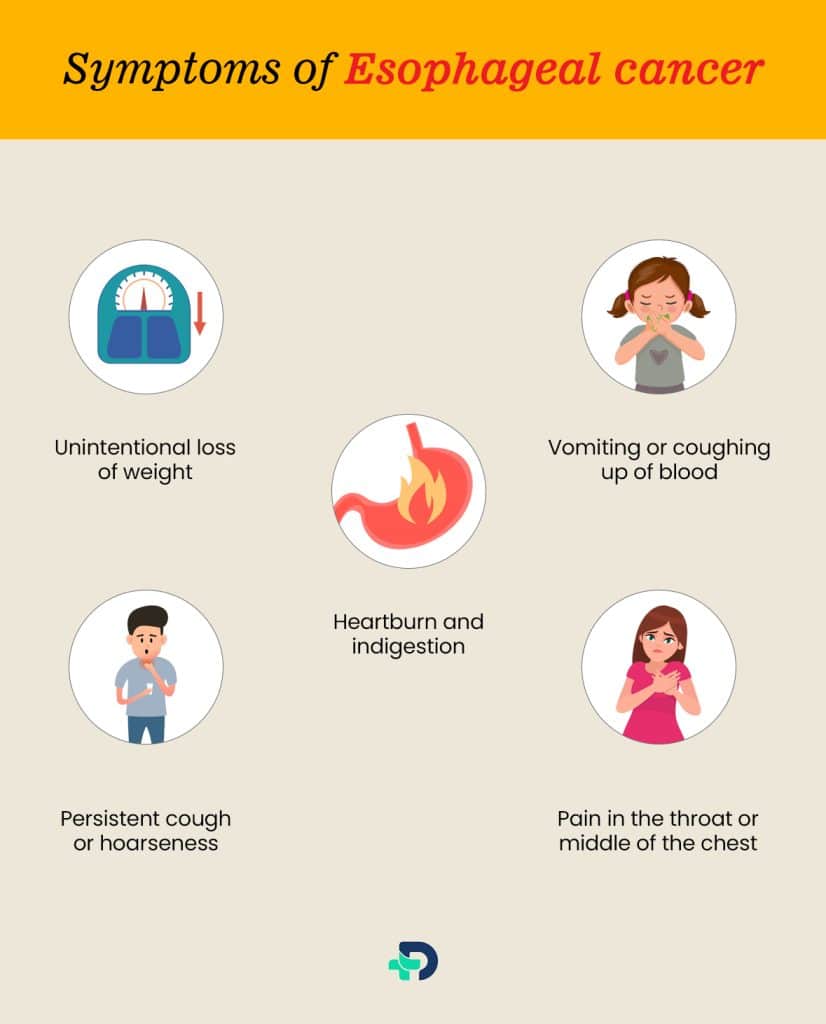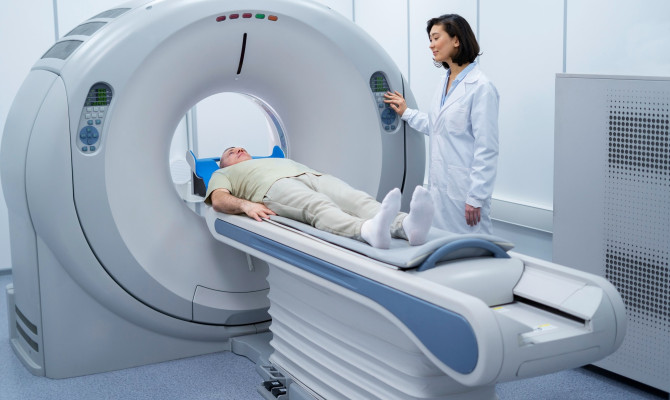Esophageal Cancer: Stages, Symptoms, and Treatment

- Esophageal cancer
- 17 Aug 2023
Overview
What is Esophageal cancer?
Esophageal cancer first manifests itself in your esophagus, a lengthy, muscular tube that transports food from the throat to stomach. Even after the malignancy has spread, esophageal cancer tumors can occasionally show no signs.
Early cancer detection may allow medical professionals to use surgery and other therapies to completely eradicate the disease. When cancer cannot be cured, doctors concentrate on extending life, alleviating symptoms, and maintaining quality of life1Overview| Researched based study from Clevelandclinic.org

Types
Types of Esophageal cancer
According to the type of cell in which they develop, esophageal malignancies are categorized.
The following are the two main kinds of esophageal cancer:
Adenocarcinoma
- Adenocarcinomas are tumors that originate in gland cells at the bottom of the esophagus. This form of esophageal cancer is the most prevalent. Typically, it takes place nearer to the stomach. Chronic heartburn, GERD, Barrett’s esophagus, and persistent acid reflux may all raise your risk of getting adenocarcinoma of the esophagus.
Squamous Cell Carcinoma
- The mucosa, the inner layer of the esophagus, is normally lined with squamous cells which refers to the type of cancer that develops in these cells. The cervical esophagus and the upper two-thirds of the chest cavity are where this type of esophageal cancer most frequently develops, though it can develop anywhere along the esophagus2Types| Researched based study from Cancer.orgv
Symptoms

Symptoms of Esophageal cancer
Esophageal cancer typically exhibits no symptoms or warning signs in its early stages. Dysphagia, or difficulty swallowing, is frequently the most prevalent symptom once the disease has progressed and is brought on by the esophageal opening contracting and shrinking. Over time, this symptom typically gets worse.
The following are other symptoms of esophageal cancer:
- Unintentional loss of weight
- Heartburn and indigestion
- Vomiting or coughing up of blood
- Persistent cough or hoarseness
- Pain in the throat or middle of the chest, especially during swallowing 1Symptoms| Researched based study from Clevelandclinic.org
Risk factors
Risk factors of Esophageal cancer
The specific cause is unknown, although medical professionals have identified risk factors that raise the possibility of acquiring esophageal cancer, such as:
- Age – After age 50, the incidence of esophageal cancer increases
- Gender – The likelihood of men developing esophageal cancer is almost three times higher than that of women
- Tobacco and alcohol – These raise the chance of cancer development, particularly squamous cell carcinoma
- Obesity – Being overweight and obese might cause esophageal inflammation that could develop into cancer
- Diet- The risk of esophageal cancer might be raised by a diet that is deficient in particular vitamins, minerals, and fruits and vegetables
- Human papillomavirus (HPV) – A common virus called HPV can alter the tissue in your mouth, vocal chords, hands, feet, and genitalia, which further increases the risk
- Cancer history – Esophageal cancer is more likely to develop in those who have had head or neck cancer
- Chronic acid reflux and Barrett’s oesophagus – A alteration in the cells at the lower end of your oesophagus brought on by persistent, untreated acid reflux is known as Barrett’s oesophagus. People who suffer persistent heartburn are more prone to develop esophageal cancer, even if they do not have Barrett’s oesophagus.
- Other conditions – Several uncommon and/or inherited disorders have been connected to esophageal cancer. Achalasia is one of these, an uncommon disorder that causes swallowing difficulty. Another disorder that results in additional skin growing on the palms of the hands and soles of the feet is a rare hereditary condition called tylosis.
- Esophageal injury – It has been related to an increased risk of esophageal cancer and may result in scarring and cell damage in the area 1Risk factors| Researched based study from Clevelandclinic.org ,3Risk factors| Researched based study from Fredhutch.org
Stages
Stages of Esophageal cancer
Esophageal cancer occurs in five stages, each of which highlights the spread and seriousness of the disease:
Stage 0
- Stage Cells in this stage have displayed malignant activity without actually developing into cancer
Stage 1
- In the esophageal wall, cancer has developed. The tumor’s location might not be immediately apparent
Stage 2
- One or two lymph nodes and the muscular or connective tissue of the oesophagus have been affected by the cancer’s spread
Stage 3
- Between three and six lymph nodes, as well as the diaphragm, the sac surrounding the heart, or the protective membrane surrounding the lungs, have been affected by the cancer’s spread to the muscular or connective tissue of the oesophagus
Stage 4
- The body’s distant regions have been affected by cancer
The likelihood of a cancer being successfully treated depends on the stage at which it is discovered.2Stages| Researched based study from Cancer.org
Diagnosis
How Esophageal cancer is diagnosed?
Your doctor will examine you, take a look at your symptoms, and medical history to determine if you have esophageal cancer. They may also request certain X-rays and blood testing.
Physical examination and medical history
- A physical exam of the body to check for any anomalies or general disease indications as well as to check for general markers of health. In addition, a history of the patient’s medical history, past diseases, and medical procedures will be gathered.
Blood test
- A bleeding esophageal tumor may cause anemia, which can be identified by a complete blood count (CBC), which measures the red blood cell count. The liver’s functionality, which may be impacted by metastatic esophageal cancer, can be evaluated using a liver enzyme test.
Barium swallow test
- After the patient consumes a barium-containing liquid, a number of x-rays are obtained. A device called an x-ray is used for capturing the interior of the human body. A tumour or other unexpected changes are easier to spot on an x-ray because barium coats the surface of the oesophagus. Your doctor can advise an upper endoscopy and biopsy to determine whether a suspicious spot is malignant if it appears abnormal.
Esophagoscopy
- A procedure to examine the esophagus from the inside and look for any abnormalities. Through the nose or mouth, an esophagoscope is introduced into the esophagus and passed down the throat. . To view the stomach and esophagus, a procedure known as an upper endoscopy is performed.
Endoscopic ultrasound
- An endoscope has a tiny ultrasonic probe attached to it. The doctor then places it into the desired location through the mouth. Typically, this occurs after a patient’s cancer diagnosis but before the doctor orders a monitor-based closer inspection of the tumor. This type of test might be able to identify the cancer if it has spread to the tissue around it.4Diagnosis| Researched based study from Cancer.gov
Biopsy
- The removal of tissues or cells to allow a pathologist to analyze them under a microscope and seek for signs of cancer. Typically, the biopsy is performed during an esophagoscopy. A biopsy may occasionally reveal esophageal abnormalities that are not cancer but could develop into malignancy.4Diagnosis| Researched based study from Cancer.gov ,5Diagnosis| Researched based study from Cancer.net
Treatment
Treatment of Esophageal cancer
If the cancer has not spread to other regions of your body, your doctor might advise surgery. Instead, your doctor might suggest that you undergo chemotherapy or radiation treatment. Additionally, these procedure s are occasionally used to reduce the size of esophageal tumours so that surgery can remove them more conveniently.
Surgery
- If your cancer hasn’t spread, surgery is typically the best option. Your esophagus is completely or partially removed by surgery. The following surgical techniques may be advantageous for people with esophageal cancer:
Esophagectomy
- In this procedure, the esophagus is partially removed. The remaining esophageal tissue is joined to the stomach after the surgeon removes the part of the esophagus that contains the tumor. They might employ a little section of the large intestine to assist in bridging the gap between the esophagus and the stomach.
Esophagogastrostomy
- The surgeon removes some of the stomach’s contents, the afflicted section of the esophagus, and the surrounding lymph nodes. The surgeon may use a little section of the large intestine to join the stomach and esophagus if they are unable to do so thereafter.
Other treatment options
Chemotherapy
- This can be used in conjunction with radiation therapy and can be administered either before or after surgery, or even both. Chemotherapy can treat advanced cancer symptoms, delay or prevent recurrence, and slow the spread of the illness.
Radiotherapy
- High-energy radiation, particles, or X-ray beams eliminate cancer cells. Radiation therapy changes the DNA of cancer cells, preventing them from proliferating. A doctor can use external beam radiation or internal brachytherapy to give radiation therapy.
Immunotherapy and targeted therapy
- Immunotherapy and targeted medications try to inhibit the spread of the cancer. Immunotherapy or targeted medications may be used to reduce the likelihood of the cancer returning after surgery if it has spread to another area of the body or if it cannot be treated6Treatment| Researched based study from Mayoclinic.org ,7Treatment| Researched based study from Ucsfhealth.org
Takeaway
Key Takeaways
- Esophageal cancer is a disorder where the oesophagus’ tissues produce malignant (cancer) cells; it affects men far more frequently than women
- Esophageal cancer symptoms and signs include weight loss and painful or difficult swallowing
- Smoking, alcohol consumption, and Barrett oesophagus all increase the risk of esophageal cancer
- Once esophageal cancer has been identified, testing are carried out to determine whether the disease has spread to other organs or to the oesophagus itself
- There are a lot of variables that can affect the prognosis (chances of recovery) and treatments that are available
Any feedback on this article?
 This Articles content was accurate
This Articles content was accurate Very Informative Article
Very Informative Article I have a question or a comment
I have a question or a comment
 This article contains inaccurate content
This article contains inaccurate content This article was not helpful
This article was not helpful I have a question or a comment
I have a question or a comment
We appreciate your helpful feedback!
Checkout our social pages
References
-
Cleveland Clinic
Esophageal Cancer | Overview | Symptoms | Risk factors
-
American Cancer Society
Esophageal Cancer Stages | Types | Stages
-
Fred Hutch
Facts about Esophageal Cancer | Risk factors
-
National Cancer Institute
Esophageal Cancer | Diagnosis
-
American Society of Clinical Oncology
Esophageal Cancer Guide | Diagnosis
-
Mayo Clinic
Esophageal cancer | Treatment
-
The Regents of The University of California
Esophageal Cancer | Treatment



































